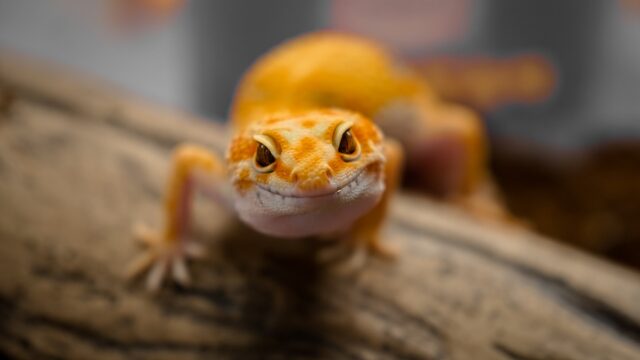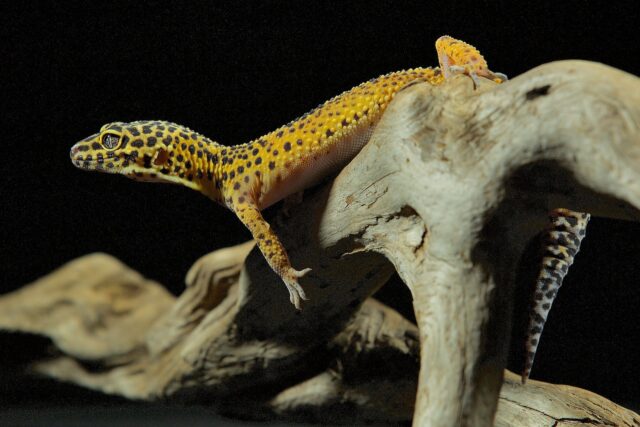Leopard geckos may change colors because of various biological and environmental factors. These factors range from shedding processes, growth stages, and temperature imbalances to UV light exposure, stress, and their habitat’s specific conditions.
Temperature Imbalance: Ensure the leopard gecko’s enclosure stays within the ideal temperature range: 88-92°F on the warm side and 75-80°F on the cool side.
UV Light Exposure: While UV light can affect gecko coloration, overexposure has risks. Consider using a heating mat instead of a UVB lamp and add extra hiding spots.
Dietary Needs: Address calcium deficiencies by adding calcium powder to their diet and always provide a small bowl of calcium without D3 in the tank. For vitamin D3, ensure they get adequate sunlight or UV light exposure.
Shedding Process: Recognize signs of shedding like hiding behavior and pale skin. Post-shedding, check for retained shed skin in areas like toes and eyes.
Growth-Related Changes: As leopard geckos grow, especially around a year old, darkening of the skin is natural and expected.
Why Do Leopard Geckos Change Colors?

Leopard geckos change colors due to a combination of biological and environmental reasons. Their unique coloration isn’t just for display; it can also be a reflection of their overall health, age, and environmental conditions they’re subjected to.
One primary reason for their color changes is the shedding process. As leopard geckos grow, they naturally shed their skin. During this shedding process, their color may appear duller or even take on a grayish hue. Once the shedding is complete, their vibrant colors return. This shedding can happen multiple times a year, especially during their growth phase.
Environmental factors also play a significant role in influencing a leopard gecko’s coloration. Temperature imbalances in their enclosure can cause color changes. Leopard geckos are ectothermic, meaning they rely on external sources to regulate their body temperature. If their environment is too cold or too warm, it might result in a temporary color change. For instance, a colder environment might cause them to darken to absorb more heat, while a warmer environment could lead to a lighter coloration to reflect heat.
UV light exposure is another factor. While UV light can be beneficial for many reptiles, excessive exposure without proper hiding spots can lead to color changes in leopard geckos. Providing a variety of hiding spots allows them to regulate their UV exposure, maintaining their health and vibrant colors.
Lastly, the type of heating pad/mat used and its placement can influence their color. Proper heat sources help in digestion and overall well-being, while an inadequate heat source can lead to stress and subsequent color changes.
8 Reasons Why Leopard Geckos May Change Colors

Leopard geckos, with their diverse range of vibrant colors, can undergo noticeable color changes throughout their life. These changes can be influenced by a variety of factors, from their environment to their diet.
To better understand and care for these fascinating reptiles, it’s essential to delve into the primary reasons behind their color transformations. Here are eight key factors that contribute to the color changes observed in leopard geckos.
1. Temperature Imbalance
Temperature plays a pivotal role in the well-being of leopard geckos, influencing not only their behavior but also their coloration. A temperature imbalance in their enclosure can lead to significant color changes. When their environment becomes too cold, leopard geckos might darken to absorb more heat, while an overly warm environment could cause them to become lighter to reflect excess heat.
2. UV Light Exposure
UV light exposure plays a significant role in the health and coloration of leopard geckos. While UV light is essential for many reptiles to synthesize vitamin D3, it can also affect the leopard gecko’s coloration. Moderate UV exposure can enhance their colors, making them appear more vibrant. However, there’s a fine line between beneficial and harmful UV exposure.
Overexposure to UV light can lead to stress and potential skin damage in leopard geckos. Prolonged exposure without adequate shade or hiding spots can result in faded or altered colors, indicating distress or health issues that could even involve their eyes. It’s crucial to strike a balance to prevent potential risks associated with UV light.
3. Calcium Deficiencies
Calcium deficiencies in leopard geckos can lead to significant health issues, affecting their overall well-being and even their coloration. Addressing these deficiencies is crucial for their long-term health. One of the primary ways to combat this is by adjusting the gecko’s diet. Incorporating calcium powder or supplements into their meals can help ensure they receive the necessary nutrients.
A vet should be consulted if there are any serious concerns about the gecko’s health, and he may do some blood work or even ask for a poop sample in order to have it analyzed.
4. Vitamin D3 Deficiencies
Vitamin D3 plays an integral role in a leopard gecko’s health and well-being. It aids in calcium absorption, ensuring the gecko’s bones and muscles function optimally. A deficiency in vitamin D3 can manifest in various ways, including changes in the gecko’s skin color. Such color alterations can signal underlying health concerns and should be addressed promptly.
5. Stress Can Also Be a Cause
Leopard geckos, like many animals, can experience stress, and this can have a direct impact on their appearance, including skin color. Various factors can induce leopard gecko stress. These can range from environmental conditions such as improper temperatures or humidity to more behavioral aspects like frequent handling or inadequate diet.
6. The Shedding Process
The shedding process is a natural and essential aspect of a leopard gecko’s life. As they grow, it becomes necessary for them to shed their old skin to make way for new, healthy skin. This process, while routine, can lead to noticeable color changes. During the shedding phase, leopard geckos might appear duller, with their vibrant colors temporarily masked by a pale or grayish hue.
The frequency of shedding can vary, especially based on age. Younger geckos, which grow rapidly, may shed more often, sometimes every few weeks. In contrast, adult geckos typically shed once every month or two.
7. The Leopard Gecko is Growing Up
As leopard geckos age, they undergo various physical transformations, and one of the most noticeable changes is in their coloration. Just like humans experience changes in their skin and hair as they mature, leopard geckos also exhibit alterations in their skin color as they transition from juveniles to adults.
One significant change observed in many geckos is the darkening of the skin. This natural process is especially pronounced when the gecko reaches about a year old. It’s a sign of maturity and can be compared to how many animals display different colors or patterns as they grow. This darkening isn’t indicative of any health issues but is merely a part of their natural growth and development.
Different species or morphs of leopard geckos can have varying color patterns when fully grown. For instance, the Giant leopard gecko often has a more pronounced darkening compared to the standard leopard gecko. Similarly, the Black Pearl leopard gecko is known for its darker coloration when it reaches adulthood.
8. Darkening of Skin Because of Substrate in the Tank
The substrate in the tank, or the material that lines the bottom of the gecko’s enclosure, can influence various aspects of a leopard gecko’s life, including their skin color. Some substrates can lead to the darkening of the leopard gecko’s skin. This darkening can occur when the gecko burrows or rests on darker substrates, and the color temporarily transfers to their skin.
What Kind of Color Changes Can Be Expected?
Leopard geckos are known for their diverse and vibrant colorations, which can evolve and shift throughout their lives. From natural growth and shedding to environmental factors and health concerns, various triggers can influence these color changes. Understanding the types and reasons behind these shifts not only aids in their care but also deepens the appreciation for the dynamic beauty of these captivating reptiles.
Darker Colors & Brighter Colors
Darker colors and brighter colors in leopard geckos can result from various factors. Sometimes, these color shifts are natural and harmless, while at other times, they might indicate underlying issues. Environmental factors, such as lighting, temperature, and humidity, can play a significant role in these color changes. For instance, a gecko might display darker colors when trying to absorb more heat or appear brighter after a successful shedding process.
It’s noteworthy when dark colors appear limited to certain body parts or manifest as unexpected dark spots. Such localized color changes might indicate bruises, injuries, or other health concerns and warrant closer observation or consultation with a veterinarian.
The shedding process is another crucial factor influencing a gecko’s color. During shedding, a gecko’s skin might appear duller and lose some of its vibrancy. However, this is temporary, and once the shedding is complete, their original vibrant colors are usually restored.
Vibrant Colors & Yellow Coloration
Leopard geckos are celebrated for their wide range of color changes, particularly their ability to display incredibly vibrant colors and various shades, including yellow coloration. These dynamic hues are influenced by a blend of genetic and environmental factors.
Factors such as age can contribute to color variations. For instance, as a gecko matures, its colors might intensify or shift. Different morphs, or genetic variations, also play a role. Some morphs naturally have brighter or more varied colorations than others.
The shedding cycle is another influential factor. Just before a shed, colors might appear subdued, but post-shed, the gecko often showcases brighter, more vivid hues.
Environmental triggers can also induce color changes. Elements like lighting, temperature, and the gecko’s overall well-being can influence its color vibrancy. Stress, for example, might cause a gecko to appear duller, while a well-regulated environment with appropriate UV exposure can enhance its natural colors.
Leopard geckos can display a spectrum of colors, from bright yellows and oranges to soft lavenders and bold blacks. The specific color palette a gecko presents can vary widely based on the individual, influenced by its genetics and environmental conditions.